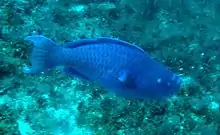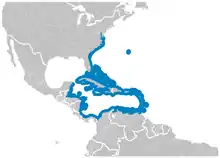Blue parrotfish
The blue parrotfish (Scarus coeruleus) is a member of the parrotfish genus Scarus. It is found on coral reefs in shallow water in the tropical and subtropical parts of the western Atlantic Ocean and the Caribbean Sea. They usually forage in a group of 500 individuals for spawning and deterring predators while feeding.[4]
| Blue parrotfish | |
|---|---|
 | |
| Blue parrotfish in Madagascar Reef. | |
| Scientific classification | |
| Domain: | Eukaryota |
| Kingdom: | Animalia |
| Phylum: | Chordata |
| Class: | Actinopterygii |
| Order: | Labriformes |
| Family: | Scaridae |
| Genus: | Scarus |
| Species: | S. coeruleus |
| Binomial name | |
| Scarus coeruleus Edwards, 1771 | |
 | |
| Blue parrotfish range.[2] | |
| Synonyms[3] | |
Description
They are uniformly blue with a yellow spot on their heads that fades as they age. They average 30 to 75 centimetres (12 to 30 in) in length with a maximum length of 1.2 metres (3 ft 11 in). They develop a large "beak" like other parrotfish that is used for scraping algae and small organisms from rocks. They have pharyngeal teeth that grind ingested rocks into sand. No other species has this uniform blue color as adults. They weigh about 9.1 kilograms (20 lb).
Reproduction
In summer, blue parrotfish gather in spawning groups. Sexual interaction occurs and the females deposit their eggs into the water column after which they sink to the seabed. The eggs hatch after about twenty-five hours.[5] Some special characteristics found in only female blue parrotfish are that there is an existence of an annually immature all-female group. The other is that females in the sexually mixed group spawn without any seasonality.[6]
Distribution and habitat
Blue parrotfish are found on coral reefs at depths of 3–25 m (9.8–82.0 ft) in the western Atlantic from Maryland in the United States to Bermuda, the Bahamas, and south to Brazil. They are also found throughout the West Indies but are absent from the northern part of the Gulf of Mexico. Juveniles are found in beds of turtle grass (Thalassia testudinum).[3] The Scarus Coeruleus fish greatly depend on coral reef systems to provide them with various food sources; however, this ecosystem has become threatened, which has now put the blue parrotfish and many other species endangered of becoming extinct from lack of food availability.[7]
Diet
Their diet consists of small organisms found in the algae that they scrape off rocks. They are described as professional sand-suckers, due to their foraging of food amongst the sandy areas that surround the reef.[8] They spend 80 percent of their time searching for food.
Status
The blue parrotfish has a wide range and is abundant in much of that range, some of which is in marine conservation areas. Although larger individuals are targeted by fishermen, the population of this fish seems to be stable overall. For these reasons, the IUCN has listed this fish as being of "Least Concern".[1]
References
- Rocha, L.A.; Choat, J.H.; Clements, K.D.; Russell, B.; Myers, R.; Lazuardi, M.E.; Muljadi, A.; Pardede, S.; Rahardjo, P. (2012). "Scarus coeruleus". IUCN Red List of Threatened Species. 2012: e.T190709A17797173. doi:10.2305/IUCN.UK.2012.RLTS.T190709A17797173.en. Retrieved 18 November 2021.
- International Union for Conservation of Nature (IUCN) 2012. Scarus coeruleus. In: IUCN 2015. The IUCN Red List of Threatened Species. Version 2015.2. "The IUCN Red List of Threatened Species". Archived from the original on 27 June 2014. Retrieved 2014-06-27.. Downloaded on 24 July 2015.
- Froese, Rainer; Pauly, Daniel (eds.) (2019). "Scarus coerulus" in FishBase. December 2019 version.
- Jonna, R. Jamil. "Scaridae (Parrotfishes)". Animal Diversity Web. Retrieved 29 October 2022.
- "Blue Parrotfishes, Scarus coeruleus". MarineBio Conservation Organisation. Archived from the original on 14 March 2016. Retrieved 27 December 2013.
- Ebisawa, Akihiko; Kanashiro, Kiyoaki; Ohta, Itaru; Uehara, Masato; Nakamura, Hiroyuki (September 2016). "Changes of group construction accompanying with growth and maturity in blue-barred parrotfish (Scarus ghobban), and influences of the fishing targeting the immature group to the stock". Regional Studies in Marine Science. 7: 32–42. doi:10.1016/j.rsma.2016.01.012.
- Lindholm, J., Knight, A., Kaufman, L., et al. (2006). Site Fidelity and Movement of The ParrotFishes Scarus Coeruleus and Scarus Taeniopterus at Conch Reef (Northern Florida Keys). Caribbean Journal of Science., 42(1), 138-144.
- Overholtzer, Karen L.; Motta, Philip J. (11 February 1999). "Comparative resource use by juvenile parrotfishes in the Florida Keys". Marine Ecology Progress Series. 177: 177–187. Bibcode:1999MEPS..177..177O. doi:10.3354/meps177177.
Further reading
- Lindholm, James; Knight, Ashley; Kaufman, Les; Miller, Steven (2006). "Site fidelity and movement of the parrotfishes Scarus coeruleus and Scarus taeniopterus at Conch Reef (northern Florida Keys)". Caribbean Journal of Science. 42 (1): 138–144.
External links
- Photos of Blue parrotfish on Sealife Collection
